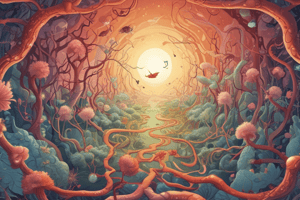Podcast
Questions and Answers
What is the study of the interactions between organisms and their environment?
What is the study of the interactions between organisms and their environment?
- Biochemistry
- Evolutionary Biology
- Genetics
- Ecology (correct)
Which biological molecule provides energy for the body?
Which biological molecule provides energy for the body?
- Nucleic Acids
- Proteins
- Carbohydrates (correct)
- Lipids
What is the control center of the cell where DNA is stored?
What is the control center of the cell where DNA is stored?
- Mitochondria
- Nucleus (correct)
- Lysosomes
- Ribosomes
What is the process by which cells generate energy from glucose?
What is the process by which cells generate energy from glucose?
What is the study of microorganisms, including bacteria, viruses, and other microbes?
What is the study of microorganisms, including bacteria, viruses, and other microbes?
What is the semi-permeable membrane that surrounds the cell and regulates what enters and leaves?
What is the semi-permeable membrane that surrounds the cell and regulates what enters and leaves?
What is the sum of all chemical reactions that occur within an organism?
What is the sum of all chemical reactions that occur within an organism?
What is the ability of an organism to maintain a stable internal environment despite changes in the external environment?
What is the ability of an organism to maintain a stable internal environment despite changes in the external environment?
Flashcards are hidden until you start studying
Study Notes
Branches of Biology
- Botany: study of plants, including their structure, growth, evolution, classification, and distribution
- Zoology: study of animals, including their structure, growth, evolution, classification, and distribution
- Microbiology: study of microorganisms, including bacteria, viruses, and other microbes
- Ecology: study of the interactions between organisms and their environment
- Genetics: study of heredity, genes, and genetic variation
- Biochemistry: study of the chemical processes that occur within living organisms
- Molecular Biology: study of the structure, function, and interactions of biological molecules such as DNA, proteins, and carbohydrates
- Cell Biology: study of the structure, function, and behavior of cells
- Evolutionary Biology: study of the processes that have shaped the diversity of life on Earth
- Marine Biology: study of organisms that live in the ocean
- Conservation Biology: study of the preservation and protection of threatened and endangered species and ecosystems
Biological Molecules
- Carbohydrates: provide energy for the body, examples include sugars and starches
- Proteins: perform a wide range of functions, including structural, enzymatic, and transport roles
- Lipids: provide energy and structure, examples include fats and oils
- Nucleic Acids: store and transmit genetic information, examples include DNA and RNA
Cell Structure and Function
- Cell Membrane: a semi-permeable membrane that surrounds the cell and regulates what enters and leaves
- Cytoplasm: a gel-like substance inside the cell membrane where metabolic processes take place
- Nucleus: the control center of the cell where DNA is stored
- Mitochondria: the powerhouses of the cell where energy is produced
- Ribosomes: small organelles where protein synthesis takes place
- Lysosomes: membrane-bound sacs that contain digestive enzymes and help break down and recycle cellular waste
Biological Processes
- Photosynthesis: the process by which plants and some other organisms convert light energy into chemical energy
- Respiration: the process by which cells generate energy from glucose
- Metabolism: the sum of all chemical reactions that occur within an organism
- Homeostasis: the ability of an organism to maintain a stable internal environment despite changes in the external environment
- Growth and Development: the process by which an organism grows and develops from a single cell to a mature individual
Branches of Biology
- Botany focuses on plant science, covering structure, growth, evolution, classification, and distribution.
- Zoology examines animal life, encompassing structure, growth, evolution, classification, and distribution.
- Microbiology investigates microorganisms, including bacteria, viruses, and other microbes.
- Ecology explores interactions between organisms and their environment, pivotal for understanding ecosystems.
- Genetics studies heredity, genes, and variations, critical for understanding inheritance and evolution.
- Biochemistry addresses chemical processes within living organisms, linking biology to chemistry.
- Molecular Biology delves into biological molecules like DNA and proteins, focusing on their structure and function.
- Cell Biology investigates cell structure, functionality, and processes vital for life.
- Evolutionary Biology examines the mechanisms behind the diversification of life on Earth.
- Marine Biology specializes in oceanic organisms, highlighting adaptations and ecosystems in marine environments.
- Conservation Biology aims to protect endangered species and ecosystems, emphasizing biodiversity preservation.
Biological Molecules
- Carbohydrates are essential for energy, with sugars and starches as primary examples.
- Proteins serve diverse roles, including structural support, enzymatic activity, and transport functions.
- Lipids provide both energy storage and structural components, including fats and oils for cell membranes.
- Nucleic Acids, such as DNA and RNA, are crucial for storing and transmitting genetic information.
Cell Structure and Function
- The Cell Membrane controls the entry and exit of substances, maintaining the internal environment's stability.
- Cytoplasm is a gel-like medium where metabolic activities occur, facilitating biochemical reactions.
- The Nucleus serves as the cell's control center, housing DNA and overseeing cellular functions.
- Mitochondria are the energy-producing units of the cell, generating ATP through respiration.
- Ribosomes are responsible for protein synthesis, crucial for cellular function and growth.
- Lysosomes contain digestive enzymes, aiding in the breakdown and recycling of cellular waste materials.
Biological Processes
- Photosynthesis converts light energy into chemical energy, primarily in plants, vital for food production.
- Respiration generates energy from glucose, essential for cellular processes.
- Metabolism encompasses all chemical reactions in an organism, supporting life activities.
- Homeostasis maintains stable internal conditions despite external environmental changes, crucial for survival.
- Growth and Development tracks an organism's progression from a single cell to a fully mature entity, crucial for life cycles.
Studying That Suits You
Use AI to generate personalized quizzes and flashcards to suit your learning preferences.




